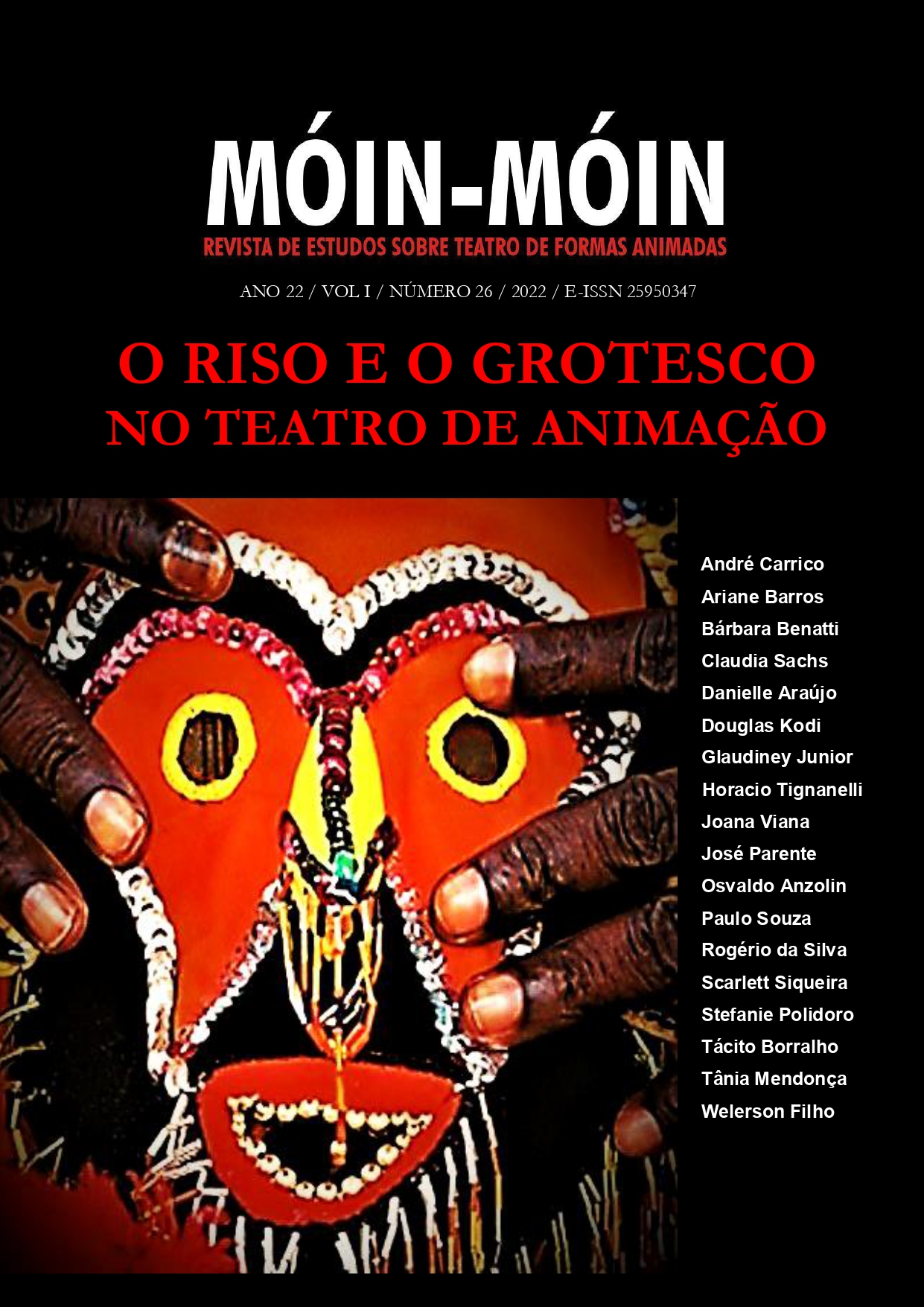Does the grotesque happen by catastrophe? from the personal experience with Ternurinha to Cabeção, by Maria Eugênia Tita
DOI:
https://doi.org/10.5965/2595034701262022136Keywords:
Maria Eugênia Tita, grotesque, laughter, laughableAbstract
This article begins by presenting a path of investigation about the grotesque, emphasizing the relationship between the actress and her buffoonish character Ternurinha. The perspective adopted to approach the theme of the grotesque is elaborated from the dialogue with the American linguist Mary Russo, with the professors and researchers in the area of communication at UFRJ Muniz Sodré and Raquel Paiva, and with the Swiss psychoanalyst Carl Jung. Based on this dialogue, it is asked whether the grotesque is necessarily laughable, and about it, the question of researcher, teacher and clown Ana Fuchs is discussed: “What are we laughing at?”. The last part of the article is dedicated to Cabeção, a character created by the dancer, researcher, and player Maria Eugênia Tita, brought to exemplify and help to reflect on the grotesque states that can be perceived from him.
Downloads
References
CABRAL, Muniz Sodré A.; SOARES, Raquel Paiva de A. O império do grotesco. Rio de Janeiro: Mauad, 2002.
FUCHS, Ana Carolina Müller. O Sorriso da Palhaça: pedagogias do riso e do risível. 2020. 295 f. Tese (doutorado) Universidade Federal do Rio Grande do Sul, Faculdade de Educação, Programa de Pós-Graduação em Educação: Porto Alegre, 2020. Disponível em: https://www.lume.ufrgs.br/handle/10183/218425. Acesso em: 6 mar. 2023.
JUNG, Carlos. G. A vida simbólica. Petrópolis: Vozes, 1998. V. XVIII.
LOTTA, Gabriela; OLIVEIRA, Vanessa Elias de; PIRES, Roberto. Burocracia e políticas públicas no Brasil: interseções analíticas. Brasília: Ipea: Enap, 2018.
PERES, Olivia; RICOLDI, Arlene. A quarta onda do feminismo? Reflexões sobre movimentos feministas contemporâneos. In: ANPOCS. Portal das Ciências Sociais Brasileiras. 42 Encontro Anual da ANPOCS. Disponível em: http://www.anpocs.com/index.php/encontros/papers/42-encontro-anual-da-anpocs/gt-31/gt08-27/11177-a-quarta-onda-do-feminismo-reflexoes-sobre-movimentos-feministas-contemporaneos?path=42-encontro-anual-da-anpocs/gt-31/gt08-27. Acesso em: 10 jul. 2022.
POLIDORO, Stefanie Liz. Eu-Ternurinha: o processo criativo e curativo da atriz-personagem a partir de seus excessos e vivências nas ruas, e o ativismo político e feminista que compõem suas teatropalestras. Tese (doutorado) - Universidade do Estado de Santa Catarina. Centro de Artes, Programa de Pós-Graduação em Teatro. Florianópolis, 2020.
RUSSO, Mary. O grotesco feminino: risco, excesso e modernidade. Trad. Talita M. Rodrigues. Rio de Janeiro: Rocco, 2000.
TITA, Maria Eugênia. Palestra Olhares aos brincantes: possibilidades cênicas e pedagógicas a partir do universo tradicional brasileiro. Proferida no dia 24 de junho de 2022, via Google Meet.
Downloads
Published
How to Cite
Issue
Section
License
Copyright (c) 2022 Móin-Móin Magazine - Studies in the Art of Puppetry

This work is licensed under a Creative Commons Attribution 4.0 International License.
The readers are free to transfer, print and use the articles published in the Magazine, as long as there’s explicit mention to the author(s) and to Móin-Móin Magazine - Studies in Theater of Animated Forms and there are no changes on the original work. Any other use of the texts needs to be approved by the author(s) and the Magazine. In submitting an article to Móin-Móin Magazine - Studies in Theater of Animated Forms and have it approved, the author(s) agree to give away, without payments, the following rights to the Magazine: first publishing rights and the license for the Magazine to redistribute this article and its metadata to index and reference services that the editors consider appropriate.
The articles whose author(s) are identified represent the author’s point of view and not the official position of Móin-Móin Magazine. The author(s) commit to always mention the publication in the following way when publishing work in reference to the article published in Móin-Móin Magazine:
“This article was originally published by Móin-Móin Magazine volume (insert the volume), number (insert the number), in the year of (insert year) and can be accessed on: http://www.revistas.udesc.br/index.php/móin"
Plagiarism in any way constitutes an unethical publishing behavior and is unacceptable. Móin-Móin Magazine holds the right to use software or other plagiarism tracking methods to scan the submitted works.
![]()
This journal uses Attribution-NonCommercial 4.0 International– (CC BY NC 4.0).






